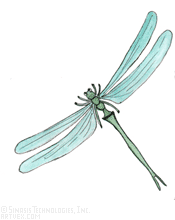
Photo credit: Creative Commons Attribution ShareAlike 2.5
I've been fortunate to see bald eagles near my apartment on many occasions. Some I've seen perched high in the trees lining a nearby gorge. Others have flown fantastically close to my living room window. Recently, one early morning, while I was on my way to work, I was gifted with the sight of three bald eagles all soaring near each other. Amazing!
Somewhere, I can't remember where it was, I've read that the bald eagles in my area are some of those that nest near the Skagit River Bald Eagle Interpretive Center in Rockport, WA. I've never been there myself, although I found out that they have presentations and group tours each winter, an annual Bald Eagle festival, and that the eagles in the area are sometimes as many as a few hundred! Apparently, when I see them around my home, they have started moving to into their westward hunting area over the local waters. Here's a website for the Skagit River Bald Eagle Awareness Team http://www.skagiteagle.org/
I've been fortunate to see bald eagles near my apartment on many occasions. Some I've seen perched high in the trees lining a nearby gorge. Others have flown fantastically close to my living room window. Recently, one early morning, while I was on my way to work, I was gifted with the sight of three bald eagles all soaring near each other. Amazing!
Somewhere, I can't remember where it was, I've read that the bald eagles in my area are some of those that nest near the Skagit River Bald Eagle Interpretive Center in Rockport, WA. I've never been there myself, although I found out that they have presentations and group tours each winter, an annual Bald Eagle festival, and that the eagles in the area are sometimes as many as a few hundred! Apparently, when I see them around my home, they have started moving to into their westward hunting area over the local waters. Here's a website for the Skagit River Bald Eagle Awareness Team http://www.skagiteagle.org/

photo courtesy of freedigitalphotos.net
photographer Tina Phillips
http://www.freedigitalphotos.net/
Here's a summary from a Wikipedia article on the Bald Eagle:
"The Bald Eagle (Haliaeetus leucocephalus) is a bird of prey found in North America that is most recognizable as the national bird and symbol of the United States of America. This sea eagle has two known sub-species and forms a species pair with the White-tailed Eagle. Its range includes most of Canada and Alaska, all of the contiguous United States and northern Mexico. It is found near large bodies of open water with an abundant food supply and old-growth trees for nesting.'
"The Bald Eagle is a large bird, with a body length of 71–106 cm (28–42 in), a wingspan of 183–234 cm, (72–96 in), and a mass of 3–7 kg (6.6–15.5 lb); females are about 25 percent larger than males.[2][3] The adult Bald Eagle has a brown body with a white head and tail, and bright yellow irises, taloned feet, and a hooked beak; juveniles are completely brown except for the yellow feet. Males and females are identical in plumage coloration. Its diet consists mainly of fish, but it is an opportunistic feeder. It hunts fish by swooping down and snatching the fish out of the water with its talons. It is sexually mature at four years or five years of age. In the wild, Bald Eagles can live up to thirty years, and often survive longer in captivity.[4] The Bald Eagle builds the largest nest of any North American bird, up to 4 meters (13 ft) deep, 2.5 meters (8 ft) wide, and one tonne (1.1 tons) in weight.[2]
The species was on the brink of extinction in the continental United States (while flourishing in much of Alaska and Canada) late in the 20th century, but now has a stable population and has been officially removed from the U.S. federal government's list of endangered species. The Bald Eagle was officially reclassified from "Endangered" to "Threatened" on July 12, 1995 by the United States Fish and Wildlife Service. On July 6, 1999, a proposal was initiated "To Remove the Bald Eagle in the Lower 48 States From the List of Endangered and Threatened Wildlife." It was de-listed on June 28, 2007.'
"The Bald Eagle remains a protected and highly revered species in the United States, and to willfully and fatally shoot or harm the species is a federal offense which can potentially result in several years of incarceration."
For further reading -- see the full Wikipedia article: http://en.wikipedia.org/wiki/Bald_eagle
Until I type again,
Kami








No comments:
Post a Comment